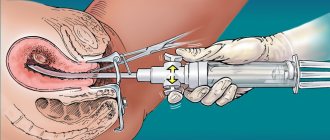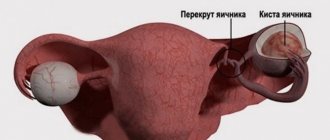Published 06/21/2019
Cervical cancer is the leading cause of death in women aged 30 to 35 years. At the same time, a woman often cannot detect the pathology on her own, experiencing minor complaints.
The cervix has a special anatomical structure. It is designed in such a way that the gynecologist can only see gross changes in the cervix, which, as a rule, are an indicator of an advanced process. A more detailed examination of the cervix for pathology is possible only under high magnification, which is precisely provided by a device called a colposcope.
Brief information
We are talking about a gynecological method for examining the female genital organs. This is a direct examination of the internal structures of the reproductive sphere under magnification. With the help of a special optical device, such a procedure becomes possible - magnification occurs several tens of times.
This examination technique is classified as a purely medical procedure, because it is performed exclusively by a doctor for the purpose of additional examination of mucous structures. The method is truly unique and in demand - it allows you to identify minimal primary changes that cannot be noticed when examined with the naked eye.
About the colposcope
We are talking about a microscope that is specially designed for non-contact study. The device has a fairly simple structure. The doctor freely places the device near the patient, choosing the most convenient location for better study.
Content:
- Brief information
- About the colposcope
- Objectives of the method
- Indications for the procedure
- Manipulation technique
- What is being assessed?
- Preparing for colposcopy
- Varieties of techniques
- Colposcopic tests
- Is there any danger to the procedure?
- Contraindications to manipulation
- The effectiveness of the technique
- After the procedure
The optical part of the device is a prismatic binocular with interchangeable eyepieces. The stereoscopic part of the device is equipped with an additional illuminator.
general information
Types of colposcopy:
- Simple - an overview method, without the use of medications;
- Extended colposcopy is a good technique for examining the cervical mucosa using various special tests;
- Video colposcopy - maximum clarity, with computer processing and display of the image on the monitor.
Diagnostic tasks:
- assess the condition of the mucous membrane of the cervix and vagina,
- better identify the lesion,
- distinguish benign changes from those suspicious for malignancy,
- carry out targeted smears and biopsies.
Colposcopy of the cervix should be done at two magnifications:
• 5-8 - for review, • 16 - for detailed examination, especially of vessels and the nature of the surface, as well as for examination of the endocervix.
Indications for use
Colposcopy of the cervix using optical magnification is carried out in order to clarify the nature of the pathological changes detected when examining it using vaginal speculum. This diagnosis allows the gynecologist to better choose a site for a targeted biopsy, and therefore colposcopy is an objective test of the effectiveness of the therapy. Carrying out colposcopy to analyze the cervix is indicated and is very useful when undergoing an annual medical examination “in gynecology”, because makes it possible to timely identify various diseases, incl. precancer and early stages of oncology. There are no contraindications to the study, no complications are observed. The optimal approach to the problem of primary diagnosis of cervical pathology includes 2 services: colposcopy and cytology. Identification of abnormalities in these tests is an indication for the second stage of screening and also includes 2 services: extended colposcopy and cervical biopsy.
Photo 1. Colposcopy of the cervix
Indications for the procedure
When is the procedure used? Doctors often prescribe colposcopy to clarify the genesis of a particular process. It may be an incomprehensible reddish spot, a strange neoplasm. The technique is prescribed if, according to the cytological examination, rather abnormal, even anomalous data are obtained. Colposcopy is always applicable for confirmed papillomatosis, before performing a biopsy.
It is better not to delay the procedure. Timely diagnosis of the slightest changes will prevent the development of a serious, deadly disease.
The manipulation is carried out to determine the need for a biopsy. The diagnostic method during pregnancy is mandatory. It will not cause any harm to the unborn baby, but will allow you to control the condition of the pregnant woman.
Why is cervical colposcopy performed?
The main purpose of colposcopy is aimed at determining the boundaries, malignancy or benignity of the pathological focus. During the research process the following can be determined:
- border of pathology;
- differentiation of the tumor process;
- identification of the inflammatory process;
- the need to perform a tissue biopsy from the pathological focus;
- exact area of tissue for biopsy.
After analyzing all the data obtained, the results of colposcopy allow the doctor to draw up a plan for further effective treatment.
Manipulation technique
The procedure is performed in a supine position. The patient lies on a gynecological chair. The doctor places a special speculum in the vagina for subsequent examination of the mucous membrane using a colposcope. During the procedure, it is possible to move the device itself closer or further, shake the mirror, and clear the canal of secretions. It is important to note that the device itself remains outside. It is placed at a distance, so there will definitely not be any uncomfortable, let alone painful, sensations.
Progress of gynecological examination
The process of vulvoscopy is in many ways similar to a regular examination by a gynecologist. A woman needs to undress to the waist and sit comfortably on a chair.
The doctor uses special instruments and a colposcope, which is located a short distance from the examination area.
- Colposcopy does not cause discomfort if the woman follows the recommendations of the gynecologist.
- After a visual examination and installation of a gynecological speculum, the doctor begins to examine the surface of the vulva, vaginal walls, and cervix. Video colposcopy allows you to display an image on a monitor screen, which gives the doctor a greater overview and recording of the results on a digital medium.
- During extended vulvoscopy, anesthesia can be used, due to the high sensitivity of the vulva during biopsy.
- If the results of a simple microscopic diagnosis do not provide a complete clinical picture, the doctor uses vinegar and Lugol to determine the contours of the pathological tissues for an accurate biopsy.
After completion of the diagnosis, the results of extended colposcopy are sent for detailed interpretation to a specialist or to a histological laboratory. The doctor gives recommendations on the woman’s behavior after colposcopy.
What is being assessed?
First of all, the relief of the mucous structures is always examined and assessed. The color of tissues, the nature and characteristics of blood vessels, the structure and development of glands are taken into account. When identifying atypical neoplasms, their structure and boundaries are clearly studied. Due to magnification, this kind of inspection is more effective.
Moreover, during colposcopy, there is often a need to collect diagnostic material. Even the diagnostic minimum of colposcopy is highlighted. We are talking about the study of urogenital secretions and cytological data. Materials are collected under the control of the apparatus - the technique is highly accurate. The procedure is completely painless. Using special brushes, epithelial structures are collected from 2 places. The cervical canal and the surface of the cervix itself are best suited. If dysplastic changes are detected, additional, targeted sampling is carried out from the most changed areas. The technique allows you to more accurately diagnose the extent and intensity of the lesion.
What time of day is best to perform a colposcopy?
Colposcopy can be performed at any time of the day. The most favorable moment for its implementation is the days of the first half of the menstrual cycle. It is best to carry out this procedure 2-3 days after the end of menstrual bleeding.
Colposcopy is not performed during menstruation, because bleeding and rejection of areas of the uterine cavity mucosa interfere with a detailed examination of the vaginal walls and the visible part of the cervix. Such a procedure will be uninformative and meaningless.
It is undesirable to perform colposcopy during the first 2-3 days after ovulation, because during this period of the cycle a large amount of mucus accumulates in the cervical canal, which distorts the results and interferes with the procedure. In the second half of the menstrual cycle, performing this diagnostic procedure is also undesirable, because after its implementation, the mucous membrane of the cervix will take a longer time to recover.
Varieties of techniques
A simple examination with a colposcope is the most common. It is, in fact, a simple, exclusively survey colposcopy.
Sometimes such a study is not enough; many experts consider it to be of little effectiveness for diagnosing complex lesions. For better, in-depth diagnosis, additional tests are used. In such cases, colposcopy turns into an extended one. There is also colpomicroscopy - histological diagnosis of the vagina. This way pathological changes can be accurately determined. The results of the histological and colpomicroscopic diagnostic method have the highest percentage of coincidences.
In addition, in many private centers and clinics, the achievements of the examination have gone further. It became possible to perform video colposcopy. During diagnostics, the image is displayed on the screen, it becomes possible to take pictures and record video procedures. The patient sees the progress of the procedure in parallel with the doctor.
Types of colposcopy of the uterus
Depending on the colposcope model used and the research methodology, the following types of colposcopy are distinguished:
- simple (overview);
- extended;
- chromocolposcopy;
- fluorescent;
- with color filters;
- colpomicroscopy.
Depending on the type of colposcope, the following can be performed:
- simple colposcopy;
- photocolposcopy (the results are reflected in photographs);
- video colposcopy (results can be recorded on various media and the patient herself can observe the examination process).
Colposcopic tests
During an extended study, a number of diagnostic tests are used to objectively assess and diagnose serious lesions. These include:
- Test with acetic acid. After application, it may cause a burning sensation in the vagina, which will quickly subside. The boundary between squamous and columnar epithelium can be clearly seen.
- Schiller's test with Lugol's solution. It is used exclusively in the absence of a reaction to iodine. Normal squamous epithelium is uniformly stained brown, abnormal areas are faintly stained.
For further histological examination, elements are taken during a biopsy.
At the end of the study, the doctor must fill out a colposcopy protocol with a preliminary conclusion. The patient is given recommendations for medical examination or therapy.
What to expect after the study?
If a simple colposcopy was performed, there are usually no consequences. The woman leads a normal life without any restrictions.
Discharge from the genital tract is possible for several days:
* during an extended study, they may have a green, yellow or brown tint - remnants of the drugs used to conduct test samples;
* bloody and spotting - after a biopsy.
Discharge is normal, is not dangerous and does not require treatment.
Sexual intercourse is possible after the cessation of vaginal discharge, but it is usually recommended to abstain from it for 10–14 days from the date of the study.
Contraindications to manipulation
This kind of procedure is completely safe, because it does not harm the body in any way. I often prescribe it even during the period of pregnancy. There are no special contraindications to performing the research technique.
The only limitation is that the procedure is never performed in the early postpartum period (usually the first months after childbirth). The procedure is not recommended immediately after destructive or surgical therapy of the uterus. But these contraindications are only temporary.
There is only one absolute contraindication – intolerance to acetic acid or the iodine element.
FAQ
Despite the fact that before the procedure the doctor talks in detail about everything that will happen, questions always remain about the examination and diagnosis. Most often, patients are concerned about the following.
Is it painful to have a colposcopy or not?
In general, the procedure is painless, especially when performed by a highly qualified doctor. Mild discomfort or tingling may occur when using solutions, but this is uncommon. Therefore, to the question whether colposcopy is painful or not, the answer is negative. If during the examination you feel severe pain, you must immediately inform your doctor.
How long does the procedure take?
On average it does not take much time. Depending on the individual case, the procedure takes 20–30 minutes.
How to prepare for cervical colposcopy?
A diagnostic test such as colposcopy does not require special preparation. But patients are not recommended to have sexual intercourse several days before the procedure, and the use of vaginal creams and douching are also undesirable.
How often can and should you do a colposcopy of the cervix and which doctor should you contact?
A referral for a diagnostic examination is given by a gynecologist. He also recommends a preventative care plan, which may include a colposcopy. It all depends on your individual situation and medical history (if any).
If there are no serious problems, then the procedure, as a preventive measure, is recommended to be performed once a year.
Are there any consequences after the colposcopy procedure?
Over the next 3-5 days, you may experience a brownish discharge due to the use of iodine or another solution. Therefore, patients are advised to bring panty liners with them to use after the procedure.
In very rare cases, slight spotting and slight discomfort in the lower abdomen may occur. Sometimes the doctor may recommend taking painkillers.
What to do after the procedure?
If nothing particularly bothers you, then there is no need to take any special action. But it is highly desirable during the period while the discharge and/or slight malaise persists:
- abstain from sexual intercourse;
- do not use tampons;
- do not take a bath (shower only) or go to the pool;
- do not douche.
The doctor will tell you more about everything at your appointment.
Is it possible to have a colposcopy during menstruation?
Testing during menstruation is not recommended because the results may be inaccurate. In this regard, the doctor is often asked the question on what day (first, last) of the cycle during menstruation can a colposcopy be done. The best time for diagnosis is the first days after the end of menstruation. The doctor agrees on this with the patient in advance.
Is it possible to have a colposcopy during pregnancy?
In general, the procedure is safe for the fetus throughout the entire period of pregnancy. And the question of whether such a diagnosis is needed or not is decided by a gynecologist.
. If there are no prerequisites and compelling reasons, the examination is not prescribed. After childbirth, colposcopy can be performed after 1.5 months.
Why is colposcopy prescribed and performed for pregnant women and at what stages (early, late) during pregnancy is it required? Here everything depends on the patient’s medical history (whether she had diseases of the reproductive system), on how the pregnancy proceeds, on the doctor’s decision. If you are afraid, worried and worried, then do not hesitate to ask the doctors of our center in St. Petersburg questions about why colposcopy during pregnancy, whether it is safe for the child, etc.
Initial examination
At the initial consultation, the doctor conducts a simple examination of the patient and collects the necessary information, asking questions about the state of health, complaints, medical history (if any), symptoms, etc.
At the initial appointment, you can also ask any concerning questions: why a colposcopy is being done, which doctor will perform the procedure, what preparation should be done, are there any contraindications, what are the indications for the examination, etc.
Diagnostics
If examination and analysis of the information received does not make it possible to make an accurate diagnosis, then the doctor gives an appointment for examination. The doctor also gives a referral for colposcopy of the cervix if the previous transcript showed poor results. If you have previously undergone this examination, then you need to tell your doctor about it and it is advisable to bring its results.
In addition to colcoscopy, the following may be prescribed: smears, ultrasound and additional examinations.
Repeated appointment
At the second visit, a direct examination is carried out and, if necessary, the diagnostic and treatment plan is adjusted if the results of other tests are already known.
Control reception
Depending on each individual case, the doctor may schedule an additional visit after the end of the course of treatment to again perform a colposcopy procedure to check for relapses and to assess the patient’s health condition.
Where can I have a cervical colposcopy in St. Petersburg?
To undergo the procedure, we invite you to visit us at the medical office. We employ highly professional diagnosticians, have modern equipment and take an individual approach to the treatment and monitoring of each patient. In addition to this, we have some of the most affordable prices for cervical colposcopy and other types of diagnostics and treatment in St. Petersburg.
The interpretation of colposcopy of the cervix shows that everything is fine with you and there is nothing to worry about, or there are still problems in gynecology. The timing of the analysis results is individual, depending on the specific situation.
The effectiveness of the technique
Today, such manipulation is rightfully considered accurate in terms of studying endometriosis, polyposis, oncological processes and precancerous conditions.
Normally, the epithelial area is light pink, shiny and smooth. Benign changes are characterized by true erosion, ectopia.
Best materials of the month
- Coronaviruses: SARS-CoV-2 (COVID-19)
- Antibiotics for the prevention and treatment of COVID-19: how effective are they?
- The most common "office" diseases
- Does vodka kill coronavirus?
- How to stay alive on our roads?









